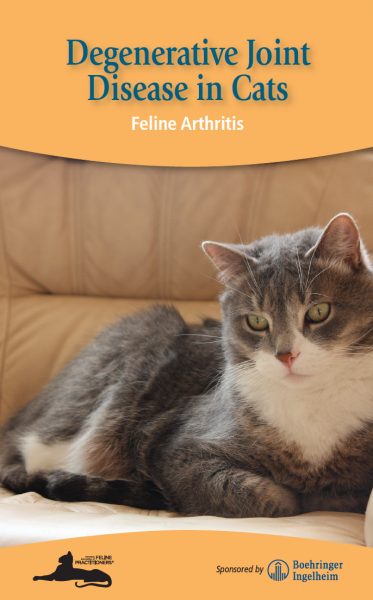Feline arthritis, also known as degenerative joint disease (DJD), is very common in cats. DJD occurs when the cartilage (firm, connective tissue that protects the ends of bones) within a joint is worn away. This lack of cartilage in the joint can cause chronic unbearable pain and can lead to poor quality of life.
Cats with degenerative joint disease most commonly have pain in their lower back, elbows, knees, hips, shoulders, and hocks (the equivalent of our ankles). Studies indicate that as many as 92% of cats may have DJD. You may think that DJD only occurs in older cats, however even young cats can get it. You just might not notice it until their condition worsens with age.
Your Role in the Diagnosis
You are crucial in finding out if your cat has DJD because you know their normal temperament, disposition, routines, and activities.
- Any change in your cat’s normal behavior may be a sign of pain
- Keep a notebook and write down your cat’s normal behavior, any changes, and/or new behaviors
- To identify changes, compare your cat’s daily behaviors and reactions in various situations to when they were young adults
- Any changes in your cat’s normal behavior can mean your cat is either in pain, sick, or stressed. These are all reasons to speak with your veterinarian right away
Signs and Symptoms
It can be very difficult to realize that your cat is in pain because the signs are subtle and difficult to identify. Cats have a natural instinct to hide or mask signs of pain or weakness. This is because cats are solitary hunters – who protect themselves from predators and perceived threats. Even cats that live solely indoors still have this protective instinct.
Cats with DJD rarely limp because the disease usually occurs in the same joint in both legs (e.g. both knees). This differs greatly from arthritis in dogs, who may exhibit more pain in one leg so there is a noticeable limp. Discomfort with walking is also easier to recognize in dogs because they are usually taken on walks outdoors.
If Your Cat Displays Any of the Following Changes, Contact Your Veterinarian Immediately
- Decreased jumping up or down, or not jumping as high as before
- Difficulty or hesitancy going up or down stairs; slower on stairs
- Stiffness
- Less active and playful
- Withdrawn, hiding, or increased “clinginess”
- Decreased grooming or over-grooming a painful area
- Aggressive when handled or towards another pet
- House-soiling (not using the litter box for urine and/or stool)
Management of the Pain
If your veterinarian diagnoses your cat with DJD, there are excellent treatments for this condition. So don’t delay and contact your veterinarian if you notice any possible signs.
Please remember to NEVER give your cat any medication without direction from your veterinarian. This includes over-the-counter drugs such as ibuprofen (i.e. Advil or Motrin), acetaminophen (i.e., Tylenol), or aspirin. Many of these drugs can be deadly to cats. Once a diagnosis is made, your veterinarian will help you develop a treatment plan for your cat. Treatment includes both medication and simple changes in your home to allow your cat to maintain their normal behaviors.


